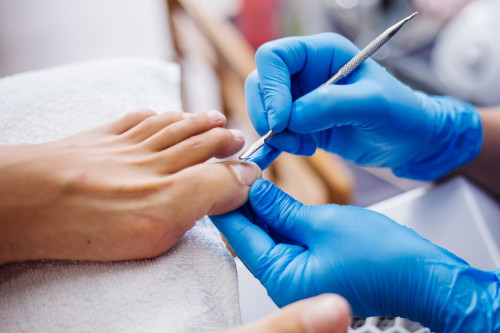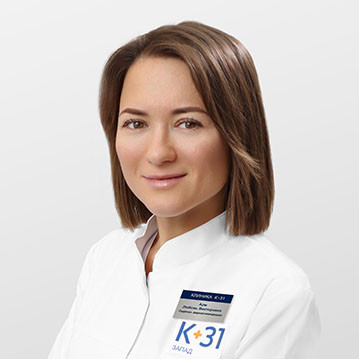Laser nail treatment
Fungal nail infection is a common infectious disease that causes both physical and aesthetic discomfort. In advanced cases, it can lead to complete loss of the nail plate. Treatment of fungus is carried out by a cosmetologist, dermatologist or podologist.

specialists

equipment

treatment

Contraindications
- Oncology
- Diabetes
- Viral infections in the acute stage
- Eczema and other skin diseases in an advanced stage
- Serious neurological problems, epilepsy
- Laser treatment of nails is not carried out within 1-2 weeks after any surgical interventions
- It is also recommended for women during pregnancy and lactation to refrain from the procedure
How is laser used to treat nail fungus?

A laser for the treatment of nail fungus deeply heats the tissue of the plate, “burning out” the layers affected by the infection. The tissues affected by the rays are not damaged at all. There are no traces of outside interference left in the affected area. Over time, the damaged tissue is removed and a healthy nail is formed in its place.
Indications for laser treatment:
- Low effectiveness of drug treatment - if you have tried several types of drugs, but have not seen the result, you should use more effective radical methods
- Allergic reactions to pharmaceuticals
- Extensive lesions involving several fingers at once
- Contraindications to the use of other treatment methods
- Thickening and deformation of the nail
The procedure is safe, so it is performed even on small children and the elderly.
Advantages
The laser beam acts locally on the mycelium of fungi without affecting healthy tissue.
- Versatility - the laser can be used not only in the treatment of fungus, but also in cases of various nail deformations, accompanied by changes in the shape and structure of the nail plate. The method can be used not only for legs, but also for arms
- Quick result - after the first session it is possible to stop the growth and reproduction of a large number of bacteria localized on the nail
- No addictive effect, as with drug therapy
- High speed of the procedure - laser treatment of fungus takes on average 15-30 minutes, depending on the number of damaged nails
- Efficiency – in 95% of patients, after laser treatment, the fungus disappears and complete recovery occurs. The method shows good results even in advanced cases
- Painless – the device is equipped with a special cooling nozzle. When exposed to the laser, the patient does not feel the slightest discomfort, except for a slight thermal effect. The procedure is performed without anesthesia
- Affordability - removing the affected nail in a safe, minimally invasive way does not require huge costs. Prices for laser treatment of fungus are in the price list on the website. The exact cost can be found out after a face-to-face consultation with a doctor
- No side effects - no allergic reactions, recovery occurs quickly and comfortably. The laser does not have a negative impact on the functioning of important organs and systems
Laser therapy for nail fungus is used both independently and in combination with other methods.

Nail fungus is dangerous
Helpful information
Contraindications to the procedure
Using laser technology to treat mycosis of the nails carries certain risks, so there are certain limitations and cautions. First of all, you need to be careful if you have low platelet levels in your blood. Laser treatment of nail fungus is also questionable in the presence of neoplasms, endocrine disorders and a weakened immune system.
Other contraindications include:
- Epilepsy
- Inflammation
- Dry skin
- Pregnancy or breastfeeding
- Infectious diseases
- Skin diseases
- Recently acquired tan (less than two weeks before upcoming treatment)
The use of medications and the presence of a tattoo in the area of intended treatment can also serve as reasons for refusing laser therapy.
Carrying out the procedure
Before starting laser treatment for nail fungus, the doctor conducts an examination to assess the stage of the disease. To confirm the presence of the disease and exclude other possible nail problems, the patient is additionally referred for blood tests.
When preparing for a laser treatment session for fungus, there are several important points to consider. First you need to remove the nail polish. In addition, it is prohibited to use creams or oils in the area to be laser treated. It is also recommended to wash your hands or feet, depending on the area where the nail fungus will be treated.
Immediately before the procedure, the nails are thoroughly cleaned and degreased. Then the doctor begins to treat the affected areas.
After laser nail removal, the doctor gives recommendations on how to prevent re-infection. In particular, the patient must maintain foot hygiene and use antifungal agents.
Changes after laser nail treatment
Already after the first laser treatment session, positive changes begin, although visually they are not yet noticeable. The pathological process occurring in the skin and nails is suspended. With each session, the condition of the nail plate will improve.
A beneficial effect can be expected a month after the start of treatment. The full results of laser therapy will be visible after 6-12 months, when the nails have gone through a full growth cycle and are completely renewed.
Comprehensive treatment of toenail fungus is effective in 90-95% of cases. If the course of the disease is complicated, the doctor may prescribe additional medications. It is this comprehensive approach that often provides the best results.
Removal of nail fungus does not guarantee a transformation of the nail in appearance, since subsequent deformations may be caused by previous injuries or strong effects of the disease itself. The main goals in the fight against fungus are getting rid of the disease and restoring the normal state of the nail plate. Please note that nail growth is incredibly slow at 0.1 mm per day for the hand and 0.03-0.05 mm for the feet, so it will take some time for the appearance of the nails to return to normal.
Relapses after treatment occur due to re-infection or failure to follow the doctor’s recommendations for further care. A completely new nail grows in 12-15 months.
Рецидивы после лечения встречаются при повторном инфицировании или невыполнения рекомендаций врача по дальнейшему уходу. Полностью новый ноготь отрастает за 12-15 месяцев.
How to sign up for a procedure at the K+31 clinic
To remove nail fungus with a laser, make an appointment at the K+31 clinic. For your convenience, there are two ways to register: online and by phone. In the first case, fill out an application on the website - indicate your full name, phone number and email address. After submitting the form, wait for the operator’s call - with him you can discuss all the details and choose a convenient time for the appointment.
You can ask any questions to the specialists of “K+31” by phone. Consultation is provided free of charge.
Our doctors

This award is given to clinics with the highest ratings according to user ratings, a large number of requests from this site, and in the absence of critical violations.

This award is given to clinics with the highest ratings according to user ratings. It means that the place is known, loved, and definitely worth visiting.

The ProDoctors portal collected 500 thousand reviews, compiled a rating of doctors based on them and awarded the best. We are proud that our doctors are among those awarded.
Make an appointment at a convenient time on the nearest date
Price
Other services
Plantar warts
Diabetic footReviews 4












What is fungal nail infection?
Fungal nail disease (onychomycosis) is a lesion of the nail plate, accompanied by a change in its color, pain and burning, inflammation of the skin, and mild itching. The complexity of the disease is that it can quickly spread to adjacent healthy nails.
Causes of the disease:
Nail fungus often occurs under the influence of additional factors: increased sweating, poor-quality or uncomfortable shoes, diabetes, weak immune system, long-term use of antibiotics or hormonal drugs.
When a fungal infection occurs, dangerous toxins can be released into the body, disrupting the functioning of important organs and systems. Therefore, it is important to seek medical help and begin treatment as early as possible.
The causative agent of fungal infection easily adapts to medications, so it is not possible to choose effective drugs in every case. Laser treatment of nail fungus shows good results. The method is effective, safe and painless, with virtually no contraindications.